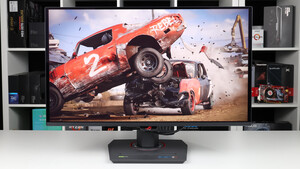The LG supports a variable refresh rate range of 72 – 144Hz. The range here is more limited than the advertised 48 – 144Hz using the ‘Extended’ mode in the OSD, but this could be just an issue with our early revision. We tried the latest available monitor driver, too, but this didn’t make a difference. That means that if the game is running between 72fps and 144fps, the monitor will adjust its refresh rate to match. When the frame rate rises above 144fps, the monitor will stay at 144Hz and the GPU will respect your selection of ‘VSync on’ or ‘VSync off’ in the graphics driver. With ‘VSync on’ the frame rate will not be allowed to rise above 144fps, at which point VSync activates and imposes the usual associated latency penalty. With ‘VSync off’ the frame rate is free to climb as high as the GPU will output (potentially >144fps). AMD LFC (Low Framerate Compensation) is also supported by this model, which means that the refresh rate will stick to multiples of the frame rate where it falls below the 72Hz (72fps) floor of operation for FreeSync. If a game ran at 32fps, for example, the refresh rate would be 128Hz to help keep tearing and stuttering at bay. This feature is used regardless of VSync setting, so it’s only above the ceiling of operation where the VSync setting makes a difference.



